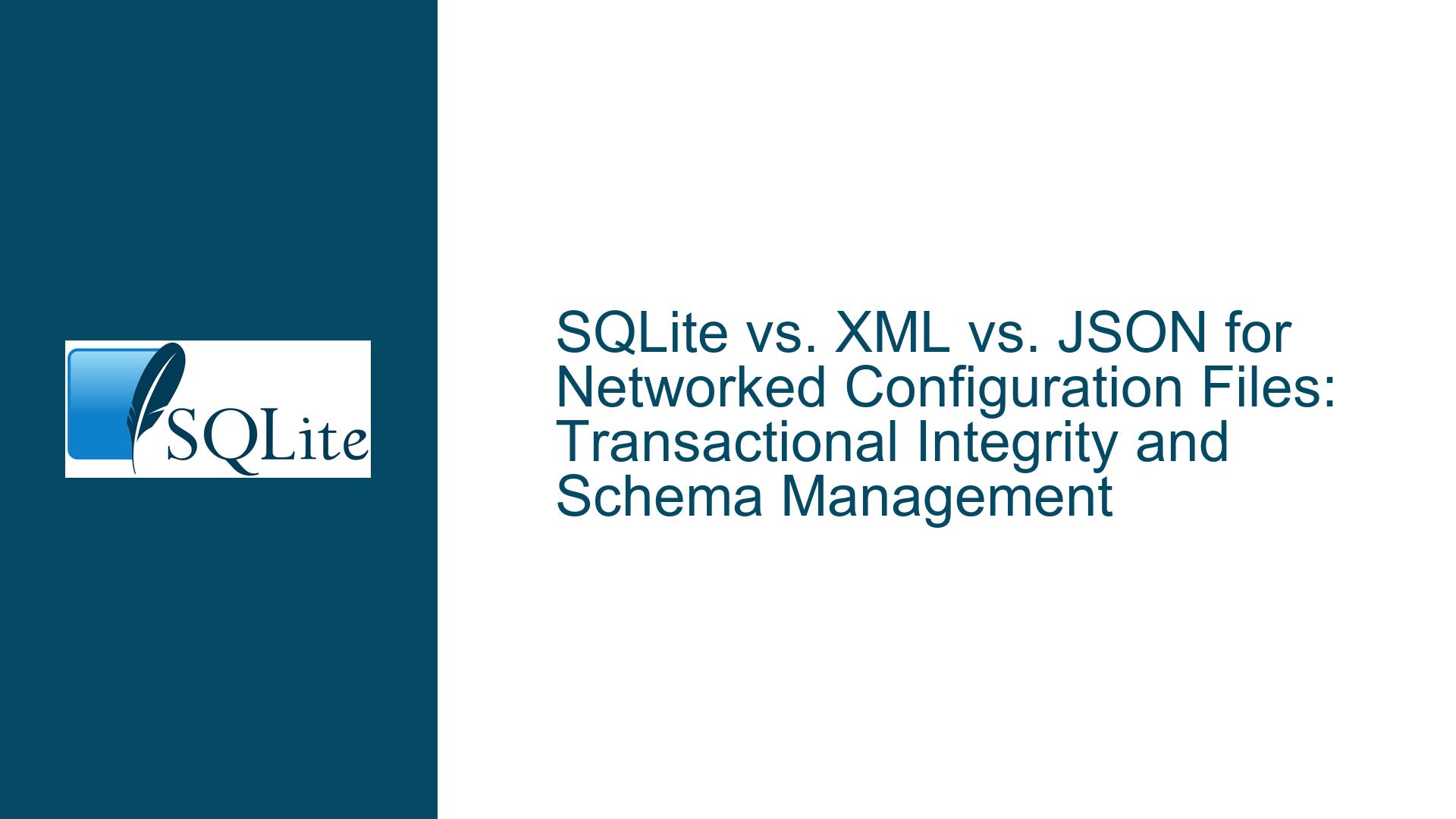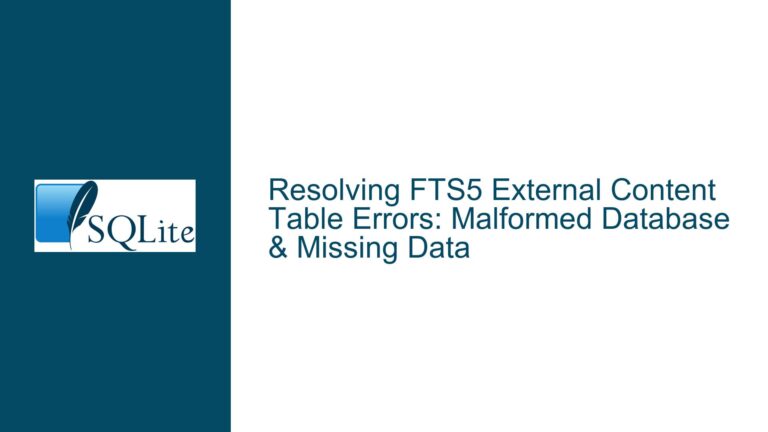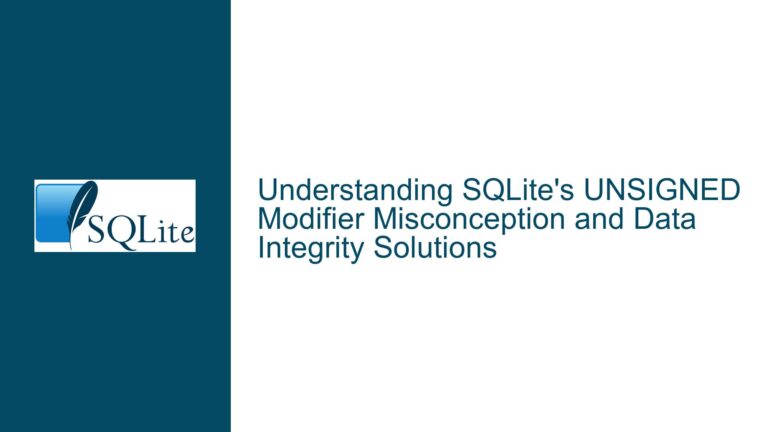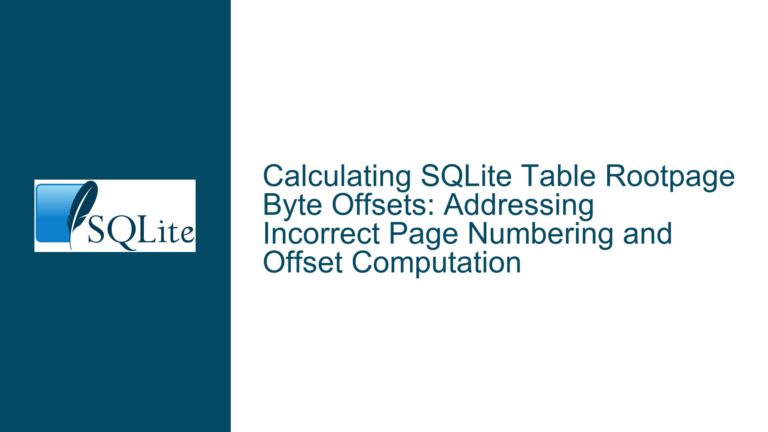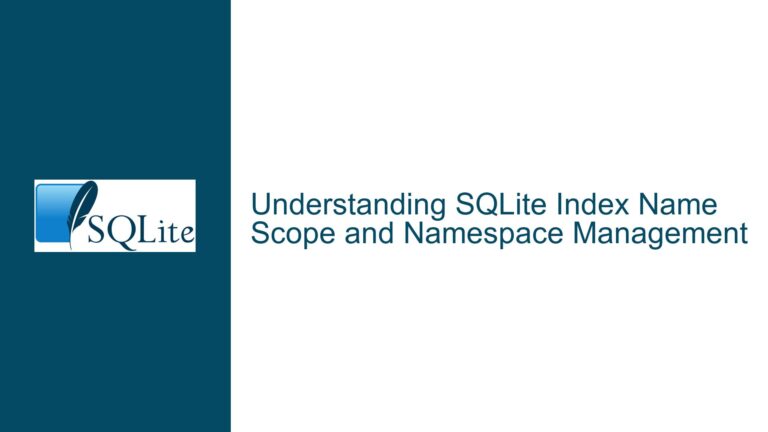SQLite vs. XML vs. JSON for Networked Configuration Files: Transactional Integrity and Schema Management
Transactional Integrity Challenges on Network File Systems
The reliability of atomic transactions in SQLite is heavily dependent on the underlying file system’s implementation of file locking and write ordering. Network file systems such as NFS (Network File System) and SMB (Server Message Block) are notorious for inconsistent locking semantics, delayed metadata synchronization, and partial writes during crashes. While SQLite’s documentation explicitly warns against using it on network shares, many applications still face this requirement due to legacy infrastructure or operational constraints. The problem arises when multiple clients attempt to read or write to the same SQLite database file concurrently over a network share. Locking mechanisms designed for local storage may not function correctly, leading to database corruption, phantom reads, or failed transactions.
This issue is not merely theoretical. For example, NFS implementations often lease locks instead of enforcing strict advisory locks, which can expire unexpectedly. SMB/CIFS may cache file handles or metadata in ways that bypass SQLite’s expectations. Even if clients coordinate via external mechanisms, the lack of a centralized lock manager at the file system level introduces race conditions. XML and JSON files face similar challenges with concurrent writes, but their text-based nature makes partial writes more detectable (e.g., malformed tags or brackets). SQLite’s binary format, however, lacks such self-describing markers, making corruption harder to diagnose.
The root cause lies in the mismatch between SQLite’s transactional model and the CAP theorem constraints of distributed systems. SQLite assumes a POSIX-compliant file system with strict locking and atomic sector writes, which network file systems rarely provide. While SQLite employs techniques like write-ahead logging (WAL) to reduce contention, these optimizations assume local storage latency and reliability. Over a network, WAL files may not sync correctly, and shared memory regions (used for WAL indexing) become inaccessible across machines.
Mitigating these risks requires a hybrid approach. One strategy is to implement a transactional proxy service that mediates access to the SQLite file. Clients communicate with the proxy via RPC or HTTP, which serializes writes and ensures atomicity at the application layer. This introduces a single point of failure but aligns with the original poster’s constraint against deploying additional server software. Alternatively, applications can adopt optimistic concurrency control by embedding version counters in the database schema. Before committing changes, clients verify that the version hasn’t changed since their read operation. If a conflict is detected, the application rolls back and retries.
For environments where a proxy is infeasible, file leasing mechanisms can approximate advisory locks. When a client opens the SQLite database, it acquires a lease from a distributed lock service (e.g., using a sidecar process that coordinates via etcd or Consul). The lease expires after a timeout, forcing clients to renew it periodically. This doesn’t eliminate the risk of split-brain scenarios but reduces the window for conflicting writes. SQLite’s busy_timeout pragma can be adjusted to wait for locks longer than default settings, though this risks client hangs if the network partition persists.
A radical alternative is to abandon direct SQLite file access and instead use SQLite in-memory databases paired with periodic snapshots to the network share. Clients load the latest snapshot at startup and periodically flush changes back. This shifts the concurrency problem to snapshot synchronization, which can be managed via checksums or hybrid logical clocks. However, this approach sacrifices real-time consistency and complicates crash recovery.
Human Readability and Editability Trade-offs Across Formats
Human readability is often cited as a strength of XML and JSON, but this advantage comes with significant operational risks. Text-based formats allow quick edits using ubiquitous tools like Notepad or vim, but a single misplaced comma or unclosed tag can render the entire file unparseable. SQLite’s binary format discourages casual edits, nudging users toward structured tools like sqlite3 CLI or DB Browser for SQLite. While this seems like a limitation, it enforces discipline: changes are made via transactional statements, reducing the risk of partial updates.
However, the original poster correctly notes that SQLite’s .dump command generates a human-readable SQL script, which can be version-controlled, diffed, and audited. This script contains both schema definitions (with comments preserved) and data as INSERT statements, combining the readability of text with the structure of a database. Gzipped dump files often achieve smaller sizes than equivalent XML or JSON, especially for tabular data. For example, a configuration file with 1,000 key-value pairs stored as a JSON object may compress poorly due to repetitive keys, whereas SQLite’s normalized schema can deduplicate common values.
The debate hinges on workflow. If configuration changes are rare and require peer review, SQLite’s dump-and-restore cycle provides an audit trail. Each change is encapsulated in a transaction, and the diff between versions is a series of SQL statements. In contrast, editing JSON or XML directly in version control leads to line-based diffs that obscure semantic changes. Consider a scenario where a configuration parameter moves from one section to another: a JSON diff shows deletions and additions, while a SQLite schema migration would use ALTER TABLE or view definitions to maintain backward compatibility.
Security is another consideration. Credentials stored in XML or JSON files are vulnerable to accidental exposure via text search tools. SQLite allows encryption via extensions like SQLCipher, enabling transparent encryption of the entire database. While JSON and XML can be encrypted as blobs, querying encrypted content requires decrypting the entire file, which is impractical for large configurations. SQLite’s granular encryption permits selective access—for example, encrypting a credentials table while leaving other tables in plaintext.
To reconcile readability with safety, teams can adopt a hybrid workflow:
- Store the canonical configuration in an SQLite database.
- Automatically generate JSON or XML exports for review using triggers or scheduled jobs.
- Validate edits to these exports with schema validators (JSON Schema, XML Schema) before importing back into SQLite.
This approach leverages the strengths of each format: human-friendly text for reviews and machine-friendly binaries for runtime. Tools like jq or xmllint can enforce formatting rules, while SQLite ensures transactional integrity during imports.
Schema Evolution and Forward Compatibility Strategies
Configuration files inevitably evolve over time. New parameters are added, deprecated fields are removed, and data types change. XML and JSON handle schema changes through optional elements and backward-compatible parsing (e.g., ignoring unknown fields). SQLite requires more deliberate planning but offers superior tools for schema migration.
The core challenge is ensuring that newer application versions can read older configuration files and vice versa. In SQLite, this is managed via the user_version pragma, which stores a schema version number in the database header. Applications can query this version and apply migration scripts as needed. For example:
PRAGMA user_version = 1;
-- Migration script for v1 to v2
CREATE TABLE new_settings ( ... );
INSERT INTO new_settings SELECT ... FROM old_settings;
DROP TABLE old_settings;
This approach is transactional: either the entire migration succeeds, or the database remains in its original state. XML and JSON lack such built-in versioning mechanisms. Developers must embed version numbers in the root element or a dedicated field and write custom migration logic.
Another advantage of SQLite is schema reflection. Applications can query sqlite_master to discover tables, indexes, and views at runtime. This enables dynamic adaptation to schema changes. For instance, if a new column is optional, the application can check for its presence using:
SELECT COUNT(*) AS exists FROM pragma_table_info('settings') WHERE name = 'new_column';
If the column is missing, the application can use default values or prompt the user to upgrade. XML and JSON require parsing the entire document into a DOM or hashmap to inspect keys, which is less efficient for large files.
To minimize downtime during schema changes, SQLite supports online migrations. New columns can be added with ALTER TABLE ADD COLUMN, which is instantaneous in SQLite 3.25.0+. For more complex changes, such as table splits or data transformations, applications can create shadow tables, copy data incrementally, and atomically swap the tables using ALTER TABLE RENAME. This ensures that reads are never blocked by ongoing migrations.
In contrast, modifying XML or JSON schemas often requires rewriting the entire file. If two processes attempt to read and write the file simultaneously, the last writer may overwrite changes. SQLite’s locking mechanisms prevent this, assuming the file system behaves correctly.
A critical consideration is default values. SQLite allows specifying defaults at the schema level (e.g., NOT NULL DEFAULT 0), ensuring that old configurations missing new fields remain valid. In JSON, missing keys must be handled in application code, which can lead to inconsistencies if developers forget to update all parsing paths.
For teams prioritizing forward compatibility, SQLite’s STRICT tables (introduced in 3.37.0) provide type enforcement, preventing accidental insertion of strings into integer columns. This complements schema migrations by catching errors early. JSON and XML schemas can be validated with external tools, but these checks are not enforced at the file format level.
In conclusion, SQLite’s structured schema management offers significant advantages for long-lived configuration files, particularly in environments where backward and forward compatibility are critical. While XML and JSON provide flexibility for ad-hoc changes, they shift the burden of data integrity to application code, increasing the risk of undetected errors.
